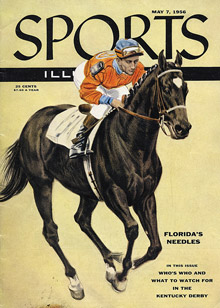
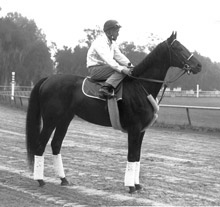
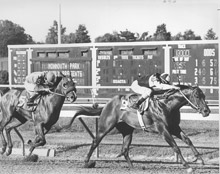
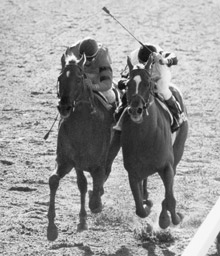
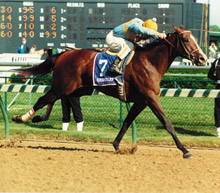
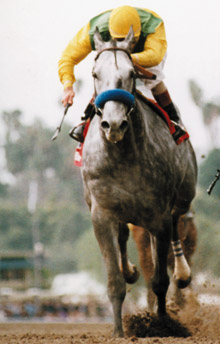
Story By Cynthia McFarland • Lead Photo By Barbara Livingston
Pick someone at random and ask them to name a horse race. Odds are they’ll mention the Kentucky Derby. There are certainly richer races, longer races, and races which have been run for more years than the Derby. Yet when it comes to prestige and glory, the famed “Run for the Roses” is the race for three-year-old Thoroughbreds.
Since Florida’s breeding industry was established around the middle of the last century, six Florida-breds have stood in the Churchill Downs winner’s circle on that first Saturday in May. Needles, Carry Back, Foolish Pleasure, Affirmed, Unbridled, and Silver Charm left their marks in the history books and made their Florida connections proud. With the running of the 130th Kentucky Derby this May, we salute the Florida-breds who have won this prestigious race.
NEEDLES – 1956
Before Needles, no Florida-bred had even run in the Kentucky Derby, let alone walked away with the winner’s coveted blanket of roses. Needles changed the way the world looked at Florida horses and made an impact on the Thoroughbred industry in his home state that is still felt to this day.
Bred by William Leach, Needles was foaled on April 29, 1953, at the Leaches’ Dickey Stables (Farm) in Ocala. His sire, Ponder, had won the Kentucky Derby in 1949, but his dam, Noodle Soup, was a less-than-spectacular runner. Five weeks after he was born, the bay foal contracted equine pneumonia, running a high fever for weeks. Needles, his unusual name, was a result of the many injections he received during his illness. Needles was meant to survive because he had a destiny to fulfill, though no one knew it at the time.
As a two-year-old, Needles was purchased by Jackson C. Dudley and Bonnie M. Heath, partners in an Oklahoma oil drilling company, as well as in their racing venture, D & H Stables. Trainer Hugh Fontaine encouraged them to buy the colt, who went on to pay back his $20,000 price tag many times over.
Needles became Florida’s first national champion when he earned the title Champion Two-Year-Old Colt of 1955, capturing six wins and two thirds out of 10 starts.
After a brilliant start to his three-year-old season, he went into the Kentucky Derby as the favorite in the field of 16 horses.
“We were extremely confident,” Bonnie Heath recalled in a 1997 interview. “We were probably too inexperienced to know better. In retrospect, I’m sure Dudley and I were overconfident, but you have to be to win races. Fontaine had done a good job getting him ready to run. Needles hadn’t really been challenged and I don’t think we were unrealistic to expect him to win.”
And win he did, before the largest crowd in Derby history at that time. Needles was trailing in 16th position going into the backstretch, but a monumental stretch run put him ahead by three-quarters of a length at the wire.
In his valiant effort to win the Triple Crown, Needles placed second in the Preakness Stakes and then won the Belmont Stakes, and ended the season as Champion Three-Year-Old Colt of 1956. Needles retired with total career earnings of $600,355. In 21 starts, he had 11 wins, three seconds, and three thirds.
Dudley and Heath kept their Florida-bred in the Sunshine State where he stood his entire breeding career at Bonnie Heath Farm in Ocala. Needles died in 1984 at the age of 31, and his monument stands at the Ocala Breeders’ Sales Complex.
CARRY BACK – 1961
Bred and trained by Jack A. Price, Carry Back was owned by Dorchester Farm, the operation established by Price and his wife, Katherine. The same year that Needles won the Kentucky Derby, the Prices sent their first group of yearlings to Ocala Stud for training.
Judging on pedigree and first impressions, one might say Carry Back hailed from the “wrong side of the tracks.” His sire was Saggy, who, despite a less-than-noble name, held the distinction of being the only horse to defeat Citation during his three-year-old campaign. A mediocre success at stud, Saggy stood for a $500 fee, and Carry Back was the result of a bargain breeding arrangement in which Price bred three mares to the stallion for $1,200.
Carry Back’s dam also had an unusual name: Joppy. Carry Back was born April 16, 1958. Fortunately for the little brown colt, the Prices declined to use any combination of sire and dam’s names when it came time to name their foal; instead Carry Back was named for a tax loophole. An Ocala Star Banner article dated November 19, 1961, quoted Joe O’Farrell of Ocala Stud as saying, “The Prices were losing so much money on their racehorses, they decided if this new one turned into a winner, they’d take the winnings and carry them back on their losses!”
As a yearling, Carry Back was a diminutive 13 hands. Even when full grown he stood just 15.1 hands and weighed in at less than 1,000 pounds.
Jack Price campaigned the two-year-old Carry Back heavily and with remarkable success. In an incredible 21 starts at two, the colt captured five firsts, four seconds and four thirds, counting among his victories a win in the $288,000 Garden State Stakes, then the world’s richest race for two year olds. That year he earned a place in the history books as Florida’s leading money-winning two year old.
As a three year old, Carry Back commanded more coverage in American newspapers and magazines than any other racehorse in the country. With characteristic candor and humor, Price did his part to keep sports writers’ pens scribbling. By the time the first Saturday in May had rolled around, Carry Back had earned his nickname as “the people’s choice.”
On Derby Day, the little brown colt ran his typical come-from-behind race, made even more impressive because of his eleventh place position after starting from post number 14. The race caller actually announced, “Carry Back will not make it today,” when the horses were on the backstretch. But Carry Back’s blazing stretch run mowed down the rest of the field, and he won the 87th Kentucky Derby by three-quarters of a length.
Carry Back went on to win the Preakness, but his Triple Crown hopes were dashed when he was injured in the Belmont and finished seventh. At the conclusion of his three-year-old season, Carry Back was voted best Three-Year-Old Colt in 1961 and was the richest horse still racing at the time.
Florida’s first millionaire, Carry Back earned $1,241,165 with 21 wins, 11 seconds, and 11 thirds in a remarkable 61 starts. He died on March 24, 1983, at the age of 25.
“He was our son, a member of our family,” recalled Jack Price at the time. “He was a terrific competitor and taught us the meaning of gameness.”
FOOLISH PLEASURE – 1975
Bred by Waldemar Farms near Williston, Foolish Pleasure was purchased by John L. Greer at the Saratoga Yearling Sale for $20,000. Greer, a successful businessman from Knoxville, Tennessee, was considered a “little owner” among the Thoroughbred ranks. He had only a handful of horses — four or five at a time — in his racing stable, bought a couple yearlings each year, and owned just a few broodmares.
Today Larry King manages Stonehedge Farm South, the former Waldemar Farms, but in 1973 he was a teenager and his father, Joe King, managed Waldemar Farms. Larry clearly recalls being at the Saratoga sale when a prominent trainer asked to see their best sale colt.
“We brought Foolish Pleasure out and the trainer said, ‘If that’s the best you’ve got, you don’t need to bring anything else out,’ Larry remembers with a laugh. “The colt toed out on both front feet and the so-called experts want a horse to be perfect, but it’s been proven over and over again that the perfect horse is not always the best runner. Horses have faults. I think what it gets down to is nobody really knows. You just have to have a hunch.”
Larry also recalls that the bay colt didn’t have the sweetest disposition and hated having his head handled. Those flaws, however, did nothing to slow him down once he hit the racetrack. Under the capable training of LeRoy Jolley, Foolish Pleasure had an undefeated two-year-old season and was voted Champion Two-Year-old Colt of 1974.
As a three year old, the colt got his first taste of defeat when he finished third in the Florida Derby. Two days later, Greer announced that Foolish Pleasure had lost most of the frogs (the V-shaped sections that act as a kind of “shock absorber”) in both front hooves when they were peeled back during the race.
“I believe he showed more courage in the Florida Derby than in any of his other races,” Greer was quoted in a Blood Horse interview in May 1975. “We didn’t want to publicize the extent of his injury at the time and have people thinking we were trying to come up with an excuse, but I really believe he showed more courage running the way he did that day he lost than he did in any of his winning races.”
Fifteen horses contested the 101st Kentucky Derby, which Foolish Pleasure won capably by 1-3/4 lengths. The game colt ran second in both the Preakness and the Belmont. Later that summer he challenged champion filly Ruffian in a match race and crossed the finish line alone after the ill-fated black filly tragically broke down before stunned viewers.
In 1976, Foolish Pleasure went on to thrill racing fans again and defeated champion Forego before retiring that year with earnings of $1,216,705. He won 16 of 26 total starts and was the sport’s 11th all-time earner upon retirement.
Foolish Pleasure was 22 when he died in November 1994.
AFFIRMED – 1978
Among the 1975 foal crop at Louise and Patrice Wolfson’s Harbor View Farm was a bright chestnut colt, later named Affirmed. He holds the distinction of being not only one of Florida’s Kentucky Derby winners, but also of being the last Triple Crown winner in racing history.
“He was probably the most personable horse I ever knew,” recalls jockey Steve Cauthen, who was just 18 when he won the Triple Crown aboard Affirmed. “He had real character, a distinct personality. He knew he was special; he would literally stop and pose for pictures.”
Trainer Laz Barrera liked to tell the story of when a camera crew came to the barn the night before one of Affirmed’s major races. The crew busied themselves setting up an array of equipment, and upon discovering this, one of the grooms made a concerned call to Barrera, who in turn hurried over to the track to check on the situation. The cause of all the commotion? Affirmed was sound asleep in his stall, completely undisturbed, and never awoke during all the fuss. He was a horse who took care of himself, and that obviously included getting a good night’s rest!
Affirmed was named Champion Two-Year-Old Colt of 1977 during a season in which he started nine times and won seven races.
The 104th Kentucky Derby was billed by many as the “East vs. West Derby”: Affirmed, the golden boy who had raced in California and Alydar, representing the Blue Grass State. Both colts came into the Kentucky Derby unbeaten in four starts at three.
Alydar was made the favorite by the crowd of more than 131,000. Alydar made a powerful move at the eighth pole and covered serious ground in the stretch, but Affirmed went on to win by 1-1/2 lengths.
The Affirmed-Alydar “duel” continued through the Triple Crown. Affirmed won the Preakness by a neck, and– to this day — many horse racing fans still consider the stretch run in the Belmont one of the most thrilling in racing history. Both colts hit the top of the stretch in unison and Alydar actually got a nose in front at the three-sixteenths pole. Affirmed regained the lead with about a sixteenth-mile to go with both jockeys riding furiously. The “photo finish” sign flashed as both horses crossed the wire, but Cauthen’s arm was already raised in a victory salute to racing’s 11th Triple Crown Winner.
As a three year old, Affirmed earned $901,541, then a record for a single year. He was voted Champion Three-Year-Old Colt and Horse of the Year in 1978. To his fans’ delight, the Wolfsons raced him another year and as a four year old, he became the first horse to earn $1 million in a single season.
Voted Horse of the Year for the second time and Champion Older Male in 1979, Affirmed retired at the end of his four-year-old season with career earnings of $2,393,818. In 29 lifetime starts, he won 22 races, had five seconds, and one third; only once did he finish off the board.
After retiring, Affirmed had a very successful breeding career in Kentucky until his death in 2001 at the age of 26.
UNBRIDLED – 1990
No one who witnessed the televised broadcast of Unbridled’s victory in the 116th Kentucky Derby will forget the stirring scene as trainer Carl Nafzger called the race for his client and friend, 92-year-old Mrs. Frances Genter, whose failing eyesight made it impossible for her to clearly see the race.
“He won it, Mrs. Genter! He won it! You’ve won the Kentucky Derby!” shouted an ecstatic Nafzger, as Unbridled cruised to victory. On their best day, racing promoters couldn’t have planned such a poignant and appealing display of the sport.
Unbridled was purchased for $70,000 as a weanling and Bryan Howlett of Tartan Farms remembers the bright chestnut colt’s early days. “He was one of our top weanlings that year. From the time he was born until we weaned him, he was one of our top picks. He was a very well-balanced colt. Even as a foal, he had a real professional attitude.”
Two-year-old Unbridled became the eighth stakes winner Nafzger trained for Mrs. Genter. The trainer remembers that Unbridled had a tremendous disposition. “Most good horses like people,” Nafzger said. “He loved kids. He had more kids on his back than he did jockeys.”
In the 116th Kentucky Derby, Unbridled was caught in tight quarters at the start, but soon settled into his stride, and went on to win by 3-1/2 lengths. In the Preakness, Unbridled ran second and was unplaced in the Belmont, but finished his three-year-old season with a victory in the Breeders’ Cup Classic and was voted Champion Three-Year-Old Colt of 1990.
During his four-year-old season, Unbridled went to the post seven times. Nafzger considers his victory in the Deputy Minister Handicap that year, when he defeated champion sprinter Housebuster, one of Unbridled’s greatest races. The chestnut colt was 15 lengths behind and powered up to win by three lengths. Unbridled retired at age four with earnings of $4,489,475, and currently is the fourth leading Florida-bred in history.
The Genter Stable dispersed in 1995, not long after Mrs. Genter passed away in the early 1990s. Nafzger still speaks of Frances Genter with great fondness and respect. “What you saw there on television was exactly what she was. She was everybody’s mother and grandmother. She was a lady beyond ladies.”
Unbridled enjoyed great success as a stallion and among his progeny is 1996 Kentucky Derby winner Grindstone and millionaire Unbridled’s Song. Unbridled was just 14 when he died in Lexington in October 2001.
SILVER CHARM – 1997
Foaled on February 22, 1994, Silver Charm made a fashionably late entrance into the world — nearly three weeks late, to be precise. He would make up for this many times by being first under the wire as a racehorse.
Bred by Mary Lou Wootton, the gray colt was born and raised at Scott and Diane Dudley’s farm in Ocala. (The late Scott Dudley was the son of Jack Dudley, who with Bonnie Heath campaigned Needles, Florida’s first Kentucky Derby winner back in 1956.)
As a youngster, Silver Charm never had a sick day or took a bad step, according to the Dudleys. “He wasn’t a bully and he wasn’t a wimp, he just always did wanted you wanted,” adds Diane. “We bring all our horses in twice a day and put our hands on them a lot. We like to think that has a lot to do with how he turned out.”
While the Dudleys sent photographs and supplied routine updates, the Woottons didn’t actually see Silver Charm “in person” until he was several months old. Looking back, even with the clarity of hindsight, Mary Lou says there was nothing at the time that seemed exceptional about the sturdy gray colt. No secret inner voice whispered, This one will make history.
But make history he did.
The Woottons consigned Silver Charm to the 1995 OBS August Yearling Sale Silver through agent Janie Roper. “It was my first yearling consignment,” recalls Janie, “so for him to have come out of that made it all the more special. He was a big, good-looking, rangy colt and we had no idea how good a horse he’d be.”
The gray colt sold for a modest $16,500 and was purchased by local successful pinhookers, Randy Hartley and Dean DeRenzo. They sold him as a two year old to California owners Bob and Beverly Lewis, who then entrusted Silver Charm to noted trainer Bob Baffert.
The colt became a graded stakes winner (the highest level of racing) as a two year old and at three continued to come into his own. He won the Kentucky Derby decisively in a stirring finish that saw fellow Florida-bred, Captain Bodgit, finish second. After he captured the Preakness Stakes, the racing world was humming in anticipation of a new Triple Crown winner. And at the Belmont, it truly looked like the world was about to witness that very thing. Unfortunately, in the last moments, challenger Touch Gold caught Silver Charm at the wire, shattering those Triple Crown hopes.
Silver Charm was Champion Three-Year-Old Colt in 1997 and also Florida-Bred Champion Three-Year-Old Colt. To the delight of fans, he raced for two more seasons before retiring in 1999 with staggering earnings of $6,944,369.
Silver Charm stands at Three Chimneys Farm in Kentucky and is off to a good start at stud. His first crop of foals raced in 2003.






